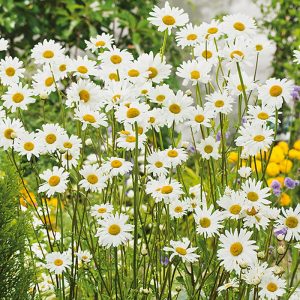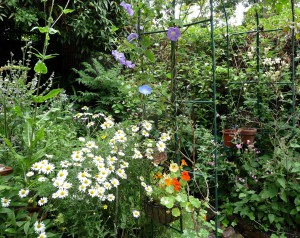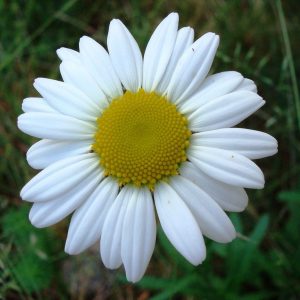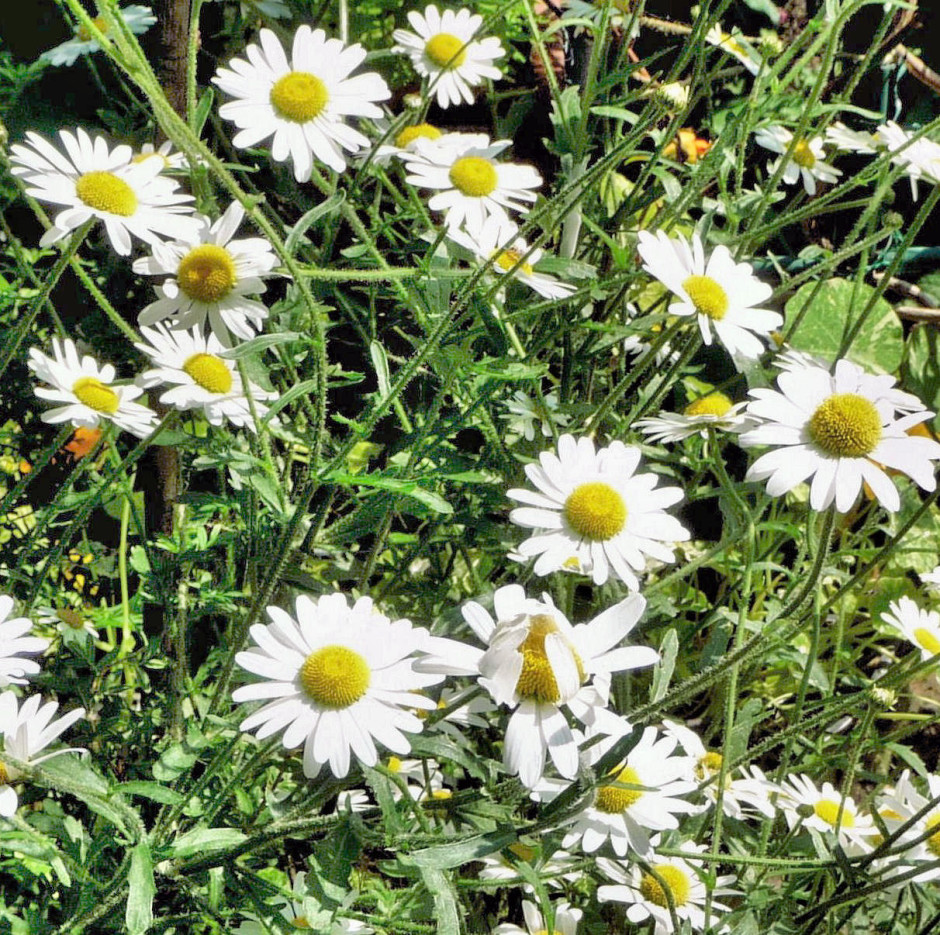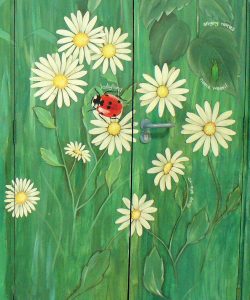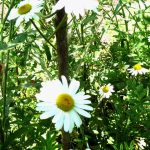OXEYE DAISY (Leucanthenum vulgare)
Europe, Asia
Oxeye Daisy is a perennial wildflower found on grassland, farmland, meadows, pastures, roadsides & along railway embankments.
The plant likes a sunny spot in moderately fertile, moist but well-drained soil that is not too wet.
Base leaves of Oxeye Daisy are spoon-shaped; the stem leaves are toothed. The plant grows to 31 inches tall & is in bloom around the summer solstice, flowering between May & September. Its flowers are discs of WHITE petals surrounding a YELLOW centre.

Bees Favourite
The yellow centre of the Oxeye Daisy is made up of many small flowers which hold nectar and are exploited by various pollinating insects including butterflies, bees and hoverflies. Woodland Trust
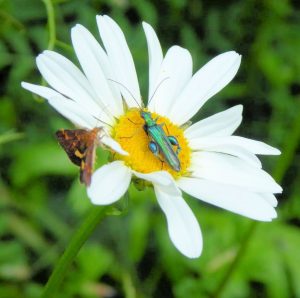 Oxeye Daisy is one of the most important plants for pollinators in the UK, & evidence from North America confirms that diverse types of pollinators, including bees, flies, beetles, ants, & moths, also use Oxeye daisies as a source of pollen and nectar.
Oxeye Daisy is one of the most important plants for pollinators in the UK, & evidence from North America confirms that diverse types of pollinators, including bees, flies, beetles, ants, & moths, also use Oxeye daisies as a source of pollen and nectar.
In Jeremy Bartlett’s blogs, he names & photographs some of the many pollinators visiting his own & other plants. High definition photos.
‘Oxeye Daisies are particularly good for wildlife and in our garden the flowers have attracted a range of insects from moths and flies to beetles and solitary bees, often with two or more species on the same flower at once, as in the photo’ (left).
Jeremy Bartlett, https://www.jeremybartlett.co.uk/2018/01/29/oxeye-daisy-leucanthemum-vulgare/
Medicinal
‘Ox-Eye Daisy has been successfully employed in whooping-cough, asthma and nervous excitability.
As a tonic, it acts similarly to Chamomile flowers, and has been recommended for night-sweats. The flowers are balsamic and make a useful infusion for relieving chronic coughs and for bronchial catarrhs. Boiled with the leaves and stalks and sweetened with honey, they make an excellent drink for the same purpose. In America, the root is also employed successfully for checking the night-sweats of pulmonary consumption, the fluid extract being taken, 15 to 60 drops in water.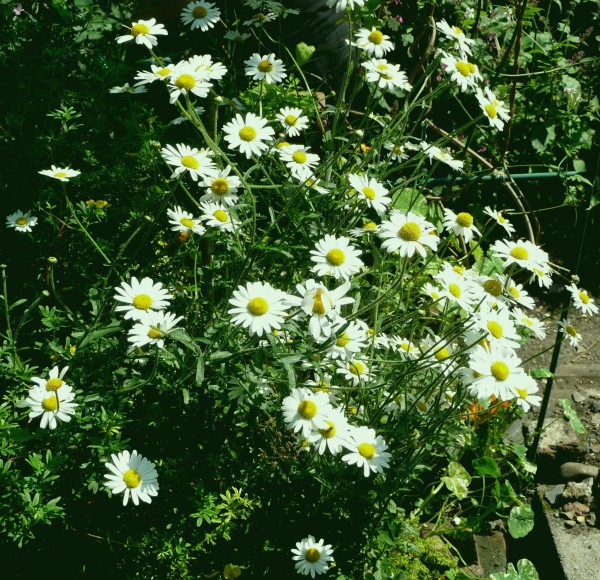
Gerard writes: ‘Dioscorides saith that the floures of Oxeie made up in a seare cloth doe asswage and washe away cold hard swellings, and it is reported that if they be drunke by and by after bathing, they make them in a short time wellcoloured that have been troubled with the yellow jaundice.’
Culpepper tells us that it is ‘a wound herb of good respect, often used in those drinks and salves that are for wounds, either inward or outward’ … and that it is ‘very fitting to be kept both in oils, ointments, plasters and syrups.‘ He also tells us that the leaves bruised and applied reduce swellings, & that ‘a decoction thereof, with wall-wort and agrimony, and places fomented or bathed therewith warm, giveth great ease in palsy, sciatica or gout. An ointment made thereof heals all wounds that have inflammation about them.’
Country people used formerly to take a decoction of the fresh herb in ale for the cure of jaundice.
Maud Grieve, A Modern Herbal 1931, Botanical.com
Invasive
Native to Europe & temperate Asia, the plant became an introduced species via gardens into Canada, The United States, Australia & New Zealand, where it has proved invasive. It is considered an invasive species in more than 40 countries. In New South Wales & Victoria it has been declared an environmental weed.
Oxeye Daisy spreads by rhizomes & seeds – a mature plant can produce up to 26,000 seeds. It is not palatable to cattle and reduces the amount of quality pasture available for grazing. In native landscapes dense infestation can exclude native plants, causing soil erosion & loss of organic matter.
Edible
In Matt Ashdown‘s blog for The Eden Project, forager Emma Gunn says Oxeye Daisy buds & flowers are edible. Together with advice on foraging for wild food, her recipe for tempura battered Oxeye Daisies is included on the website.
http://www.edenproject.com/blog/index.php/2013/07/edible-wild-food-ox-eye-daisies/
Historical
‘The daisy is a harbinger of spring’s arrival and as such many country folk felt it was a lucky flower only when it grows wild. Henry the VIII ate dandelion to calm his stomach after lush feasts. It was around this era when the Daisy was part of the healer’s kit for jaundice and small pox.
In Celtic tradition a daisy grew for each spirit of a child who died in birth. It was customary to give parents a bundle of fresh daisies to improve their spirits and allay grief. Among Christians the daisy sometimes represented the Virgin Mary who gave the flower life with her tears.’ https://www.buildingbeautifulsouls.com/symbols-meanings/flower-meanings-symbolism/daisy
In Somersetshire there is an old tradition connecting it with the Thunder God and hence it is sometimes spoken of as ‘The Dun Daisy.’ The Ancients dedicated it to Artemis, the goddess of women, considering it useful in women’s complaints. In Christian days it was transferred to St. Mary Magdalen and called Maudelyn or Maudlin Daisy after her. Gerard terms it Maudlinwort.
Maud Grieve, A Modern Herbal 1931, Botanical.com
Divination
Thought to be used in divination, especially in France, where it would be used in romantic predictions. These links to divination have filtered down to the modern game of ‘he loves me, he loves me not’ where petals are picked to determine luck in love.
Other Uses
Used in traditional medicines to treat various health problems, such as coughs and asthma. The flower heads have also been used to make tea Woodland Trust
Baldur’s Brow, Big Daisy, Bull Daisy, Butter Daisy, Caten-aroes, Crazy Bett, Dog Daisy, Drummer Daisy, Dun Daisy (Somerset), Dunder Daisy, Dutch Morgan, Fair Maids of France, Fried Eggs, Gipsy Daisy, Golden, Gowan, Great Ox-eye, Horse Daisy, Horse Gowan, London Daisy, Love-me, Love-me-not, Mathern, Magweed, Maudlinwort, Moon Daisy, Moon Penny, Poor-land Penny, Poverty Daisy, Shasta Daisy, Weed, White, White Daisy, White Gull, White Weed.
‘Its large blooms appear from June to September & are so bright that they appear to ‘glow’ in the evening, hence the common names ‘Moon Daisy’ and ‘Moon Penny’. http://www.wildlifetrusts.org/species/oxeye-daisy
Eden Project horticulturist Shirley Walker, giving tips on how to make a wildflower meadow in your garden, finishes with ‘the simple but perfect white Oxeye Daisy.’
